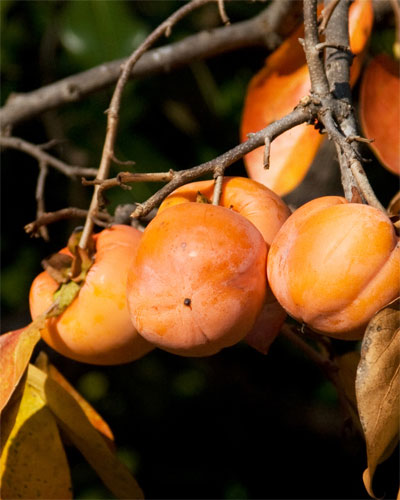Prime Time for Persimmons

You can make a great case for including a persimmon in your landscape. They’re attractive small, to medium-sized trees. Their bold leaves are dark green all summer, turning to bright shades of red, orange and yellow each fall. Their trunks are gnarly and fissured, adding great character to their surroundings during the winter. And then the fruit — what a glorious show it puts on from late fall into the winter, persisting even beyond the color change of the leaves.
Texas is native home to two species of persimmons. American persimmons (Diospyros virginiana) are native to the eastern half of the state. They’re often found in groves where many seedlings have germinated side-by-side. When allowed to develop on their own, they grow to 30 to 35 ft. tall and 20 to 25 ft. wide. Their fruit is quarter-sized and very astringent ("puckerish") until it’s exposed to at least one freeze.
Texas persimmons (Diospyros texana) are native to the Texas Hill Country and other western regions. The small trees grow to 12 to 15 ft. tall and wide, and they more closely resemble yaupon holly trees than they do persimmons. Their fruit is small, round and black.
Real garden interest in persimmons in North Texas is focused on the several varieties of Oriental persimmons (Diospyros kaki). These are the showy ones you’ll most commonly find in nurseries, particularly firms that offer recommended, well-adapted types of fruit trees. Retailers offer them in winter and into the spring. They’re also available online, but it’s best to buy from Texas-based growers. Womack Nursery in DeLeon TX (www.womacknursery.com) handles all of the common types. Their trees will be shipped bare-rooted, so mid-winter is the time to make your purchases, while the plants are dormant.
Persimmon trees need full sun for best growth and fruiting. Pay attention to each variety’s expected mature size, and be sure it will fit where you want it. Plant your tree at the same depth at which it was growing in the nursery. Water it immediately after planting, and use the excess soil you remove during the digging to make a berm to retain water as you irrigate.
Bare-rooted trees should be pruned by half at the time of planting to compensate for root loss. Apply a root-stimulator fertilizer to get the new tree started, then switch over to an all-nitrogen food beginning the second year.
Best Varieties
• Eureka. This is the most highly recommended type for Texas conditions. The trees are comparatively small at maturity, but they’re dependable producers. It is a heavy producer of mid-sized, bright red fruit.
• Fuyu. This is a popular variety that produces medium-sized fruit. It is non-astringent, meaning that the fruit can be eaten even before it is fully ripened. It is self-fertile, meaning that it will pollinate itself and other varieties as well.
• Tane-nashi. These trees are vigorous and relatively tall as they mature. The fruit is usually seedless, and it maintains good quality while hanging on the tree into the winter. It’s heart-shaped and bright orange when ripe.
• Tamopan. This is the largest, most upright of our persimmon trees, so it’s outstanding as a shade tree in a moderate-sized landscape. Its fruit has a constricted "waistline" that makes it instantly recognizable. The variety is moderately productive.
• Hachiya. This vigorous, upright tree produces acorn-shaped, seedless, dark orange fruit. Popular in California, it’s used for drying.
